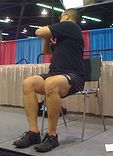Pilates In Every Day Life

There would be little point in spending time exercising if you did not take a fresh look at your posture throughout the day, as you could still be reinforcing imbalances in the body that you are now dedicating time to amending. Pilates will help to strengthen and lengthen the muscles needed to maintain good posture but you also need to learn how to carry your body in the most efficient, safest way possible all the time. Your posture, the way you hold yourself, says a lot about you. When you watch someone with very good posture enter a room, observe how your eye is drawn to them and the assumptions you can find yourself making about their lives. They seem to be in control, confident and capable. Psychologically you are also affected by your own posture, notice how much more positive you feel when you sit or stand upright. Try this when on the telephone, it will immediately give you more confidence. Posture is not just a question of how you walk or sit. To get maximum benefit from your exercise sessions, you need to get your whole body to work at maximum efficiency all the time so that it can cope with the daily demands placed on it. This means reducing imbalances throughout the body.
Sitting:
If, like a large percentage of the population, you work in an office, you are likely to sit for long periods of time, usually in chairs that are not ergonomically correct. If you are working at a computer, writing or eating, you are likely to sit in a forward flexed position, with shoulders forward, head dropping, neck muscles tensed and spine arched. Over a period of time, this posture can become the one that you adopt every time you sit, reinforcing the muscular imbalances. It is really quite difficult to sit up straight. Your torso must be strong enough to maintain a static contraction in the back and abdominal muscles to hold your body in place. Correct alignment is the same whether you are sitting, standing or lying down, it should not change because you change positions. Whether you are standing or sitting, the chest open, the abdominals contracted, the chin parallel to the floor, the feet flat on the floor.
Pilates will give you the strength to maintain correct alignment for prolonged periods of sitting. When sitting, the knees should be bent at right angles and the spine straight and lengthened but still in neutral. The legs should not be crossed. This posture can be especially difficult to maintain if you are concentrating on an activity in front of you, such as using a computer. VDU monitors that tilt and stools designed to make you sit correctly are worthwhile investments. A good way to remember your posture throughout the day is to simply write the word ” posture” on your screen saver, notice the instant effect seeing the word has on you. You can also try to enroll the help of work colleagues, ask them to remind you throughout the day of your posture and to correct you if you slip into negative habits. Whatever you are doing, stand and stretch at least once every hour. Raise your arms above your head and very gently arch and curve your back. You will feel an immediate relief in the lower back.